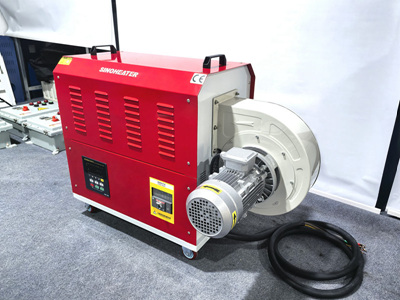Precision Heating Techniques for Shoe Upper Materials Using Hot Air Blowers
Shoe manufacturing demands precise control over material activation and bonding processes. Hot air blowers provide a non-contact heating solution to soften adhesives, activate coatings, and ensure uniform material deformation. This guide explores technical parameters, equipment configurations, and quality control measures for achieving optimal shoe upper processing.
Temperature Management for Material Activation
Effective shoe upper heating requires balancing thermal input with material properties to prevent degradation. Common materials such as synthetic leather, mesh fabrics, and thermoplastic polyurethane (TPU) have activation temperature ranges of 60–90°C, 40–70°C, and 80–110°C respectively.
Heating Stages:
- Preheating Phase: Gradually raise material temperature to 50–60°C over 3–5 minutes to eliminate residual moisture.
- Activation Phase: Maintain 70–90°C for 8–12 seconds to soften adhesives without melting base layers.
- Cooling Phase: Reduce temperature to 40°C at 5–8°C per minute to stabilize material structure.
Material-Specific Adjustments:
- Synthetic Leather: Heat to 80–85°C for optimal adhesive penetration.
- Mesh Fabrics: Limit heating to 65–70°C to prevent fiber shrinkage.
- TPU Components: Increase temperature to 95–100°C for thermal bonding.
Equipment Configuration for Targeted Heating
Hot air blowers must integrate precision nozzles, thermal sensors, and airflow control systems to achieve localized heating without damaging delicate shoe structures.
Nozzle Design:
- Conical Nozzles: Direct heat in a 20–45° angle for focused applications on small components like eyelets or logos.
- Deflector Nozzles: Create turbulent airflow to heat irregularly shaped parts uniformly.
- Slot Nozzles: Distribute heat across wide fabric panels (e.g., 20×5 cm sections) with ±2°C accuracy.
Airflow and Temperature Control:
- Variable Speed Drives (VSDs): Adjust blower motor speeds (1000–3000 RPM) to match material thickness.
- Infrared Sensors: Monitor surface temperatures in real-time, triggering automatic blower adjustments.
- Dual-Zone Heating: Combine hot air with infrared lamps for surface curing without overheating interiors.
Workspace Design:
- Insulated Chambers: Retain heat to reduce energy consumption by 15–20%.
- Ventilation Systems: Extract fumes and maintain oxygen levels to prevent oxidation.
- Ergonomic Stands: Position shoe components at 15–30° angles for optimal airflow penetration.
Process Optimization for Bonding Efficiency
Achieving flawless shoe upper assembly requires adherence to sequential protocols and defect prevention strategies.
Step-by-Step Application:
- Surface Preparation: Clean materials with isopropyl alcohol to remove contaminants affecting adhesion.
- Initial Heating: Apply hot air at 60–70°C for 2–3 minutes to soften surfaces before adhesive application.
- Adhesive Activation: Heat coated areas to 75–85°C for 5–8 seconds to activate bonding agents.
- Pressing: Use mechanical presses to apply 2–5 kg/cm² pressure for 10–15 seconds.
- Final Cooling: Cool assemblies in a controlled environment (40°C) for 5–10 minutes.
Defect Prevention:
- Thermal Shock: Avoid sudden temperature changes by limiting heating/cooling rates to 8°C per minute.
- Uneven Bonding: Rotate shoe components 180° every 2 minutes during heating to ensure symmetry.
- Residue Formation: Pre-dry materials at 50°C for 10 minutes to eliminate trapped moisture.
Advanced Techniques:
- Thermal Forming: Heat TPU overlays to 90–100°C, then press into 3D molds for precise shaping.
- Edge Sealing: Use hot air to melt synthetic leather edges, creating waterproof seams.
- Texturing: Combine hot air with embossing tools to create patterns without compromising structural integrity.
Compliance with Safety and Environmental Standards
Shoe manufacturers must adhere to regulations to protect workers and reduce ecological impact.
Safety Protocols:
- Personal Protective Equipment (PPE): Wear heat-resistant gloves, goggles, and respirators to handle fumes.
- Emergency Systems: Install automatic shutoff mechanisms for overheating (>110°C) or airflow failure.
- Fire Suppression: Equip workshops with CO₂ extinguishers and sand buckets for rapid response.
Environmental Regulations:
- Emission Control: Use catalytic converters to reduce VOC emissions from heated adhesives.
- Waste Management: Recycle material scraps and filter airborne particles with HEPA systems.
- Energy Efficiency: Implement heat recovery systems to repurpose exhaust air for preheating.
By integrating these techniques, shoe manufacturers can achieve 90–95% success rates in material bonding while maintaining compliance with international safety standards. Continuous innovation in hot air blower technology, coupled with rigorous process control, positions shoe production at the forefront of industrial efficiency and product reliability.




